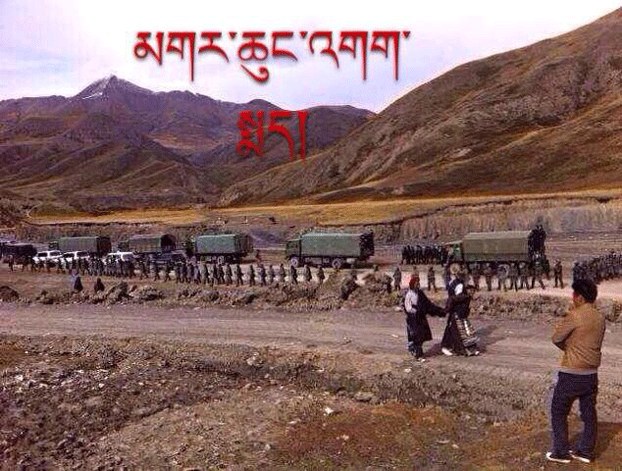




Police in Lhasa are being instructed to identify and possibly interrogate travelers entering the capital of the Tibet Autonomous Region (TAR) from a prefecture where Tibetans have protested against demands by the authorities to fly the Chinese national flag from their homes, according to an official document obtained by RFA.
The order, dated Oct. 8 and issued by authorities in Lhasa’s Old City quarter, is apparently aimed at stifling the flow of information to Lhasa on recent deadly protests in three villages in the Nagchu (in Chinese, Naqu) prefecture’s Driru (Biru) county and also prevent any spread of the demonstrations to the regional capital.
The official document blacklisted Driru, where the Tibetan villagers’ refusal to fly Chinese flags from their homes prompted a security crackdown in which Chinese police shot dead four Tibetans and injured more than 100, as well as two other counties—Sog (Suo) county and Drachen (Baqing) county.
The order called for greater scrutiny on Tibetans traveling from the three counties but did not city specific reasons for the new security procedures.
“In order to maintain social order and stability, this is to inform you how people coming from the three eastern counties of Nagchu should be identified,” says the document, a copy of which was received this week by Radio Free Asia’s Tibetan Service.
The document goes on to assign letter codes to each county—identifying Driru as A, Sog as B, and Drachen as C—and designates travelers from each county as “tourists,” reminding police to be ready to “receive” them as they cross from one area to the next.
“For example,” the order says, “if police post no. 89 learns that three ‘male tourists’ from Driru have entered the district supervised by police post no. 91, they should say, ‘Three male tourists from District A have entered your area. Please stand by to receive them.’”
Police posts inside the central Barkhor and Jokhang Cathedral area of Lhasa’s Old City must pay especially close attention to the movements of suspect persons, the memo says, adding, “And when they leave that area, police should notify the next post that they are being ‘handed over.’”
Police in these zones of the city must “strengthen the interrogation and examination of suspicious persons,” the notice says.
Weeks of protests
The police order follows weeks of protests in Driru in which Tibetan villagers defied a government order to fly Chinese flags from their homes and instead threw them into a river, triggering a security crackdown in which Chinese police fired into unarmed crowds.
In shootings on Oct. 8 in Driru’s Sengthang and Trinring villages, four Tibetans were killed and at least 50 injured, sources said.
Two days earlier, security forces shot and wounded at least 60 Driru-area Tibetans demanding the release of a villager who had led protests against Chinese orders to hoist the flags.
It is now “virtually impossible” to inform outsiders of the details of the crackdown, a local resident told RFA’s Tibetan Service on Wednesday, citing what he called “a complete blackout of communications to and from Nagchu.”
“Not only are we under strict surveillance, it has become too difficult to send information out electronically,” the source said.
Sporadic demonstrations challenging Beijing’s rule have continued in Tibetan-populated areas of China since widespread protests swept the region in 2008.
A total of 122 Tibetans have also set themselves ablaze in self-immolation protests calling for Tibetan freedom, with another six setting fire to themselves in India and Nepal.
Reported by RFA’s Tibetan Service. Translated by Dorjee Damdul . Written in English by Richard Finney.